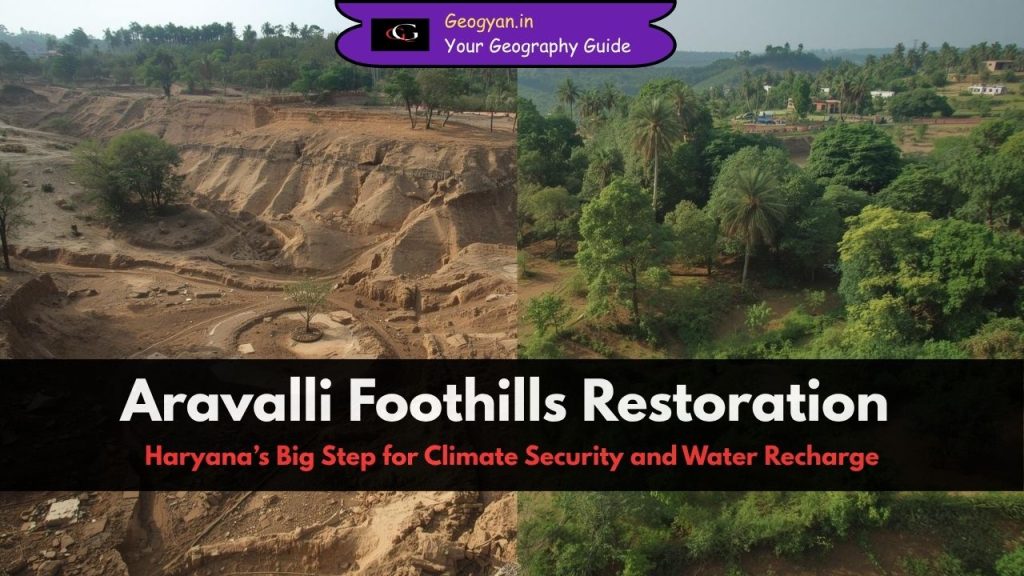Estimated reading time: 4 minutes

Table of contents
- Why is the Aravalli Restoration in News?
- About Aravalli Foothills Restoration Project
- Why is Restoration Important for Aravallis?
- Key Importance:
- Key Features of the Project
- Ecological and Wider Scope
- Quick Facts Table: Aravalli Foothills Restoration
- What are the Geographical Benefits of this Project?
- FAQs
- Also Read
Why is the Aravalli Restoration in News?
The Haryana government has announced a large-scale initiative to restore 580 acres of degraded forest land in Kasan, Khoh, and Sehrawan villages of Gurgaon district. The project, finalized under the Forest Landscape Restoration Model (FLRM), has a budget of ₹25.99 crore and will be completed in two phases by 2026.
The Aravalli Mountain system, one of the oldest fold mountain ranges in the world (dating back to the Precambrian era, over 1.8 billion years old), is ecologically significant as it acts as a barrier against desertification, supports biodiversity, and improves water recharge in the semi-arid regions of Haryana, Delhi, and Rajasthan.
The degradation of Aravallis due to mining, urbanization, and invasive species (Prosopis juliflora) has raised environmental concerns. Hence, this project is being seen as a landmark step towards ecological revival in North India.
About Aravalli Foothills Restoration Project
The restoration scheme is designed to reclaim degraded forest tracts, improve soil fertility, and enhance biodiversity.
- Total Area: 580 acres across Kasan, Khoh, Sehrawan.
- Phase 1 (2025): 326 acres restored with plantations and soil improvement.
- Phase 2 (2026): 254 acres restored with continued ecological interventions.
- Budget: ₹25.99 crore allocated by the Haryana Government.
- Model Used: Forest Landscape Restoration Model (FLRM).
Why FLRM?
This model focuses on large-scale rehabilitation of degraded landscapes, balancing human needs and ecological functions. Unlike afforestation drives, FLRM integrates ecological, social, and hydrological factors to ensure sustainable outcomes.
Why is Restoration Important for Aravallis?
The Aravalli ranges stretch across Rajasthan, Haryana, Delhi, and Gujarat. They are often referred to as the “lungs of NCR” because of their role in combating air pollution and desertification.
Key Importance:
- Environmental Shield – Prevents Thar Desert expansion into Haryana and Delhi.
- Groundwater Recharge – Enhances aquifers in semi-arid regions, critical for Gurgaon’s water security.
- Biodiversity Hotspot – Provides habitat for species like Indian leopard, hyena, jackal, porcupine, peafowl, and migratory birds.
- Carbon Sequestration – Helps mitigate climate change by absorbing CO₂.
- Urban Protection – Protects Delhi-NCR from dust storms and rising heat waves.
Key Features of the Project
- Forest Landscape Restoration adopted instead of traditional plantation drives.
- Designed as a green buffer zone along the NH-152D highway to offset land diversion.
- Native drought-resistant species to be planted: Dhau, Dak, Khairi, Ronjh.
- Invasive Prosopis juliflora (Vilayati Kikar) will be systematically removed.
- Initiative offsets the diversion of 58 hectares of forest land for highway expansion.
- Integration of biodiversity corridors to support migratory routes of animals.
Ecological and Wider Scope
The project is not limited to Gurgaon. It forms part of a compensatory afforestation drive across seven Haryana divisions:
- Kurukshetra, Kaithal, Karnal, Jind, Rohtak, Bhiwani, Mahendragarh.
Wider Benefits:
- Ecological Compatibility – Plantations suited to semi-arid conditions.
- Community Involvement – Local villagers engaged in plantation drives, soil work, and nursery setups.
- Policy Integration – Linked with National Afforestation Programme (NAP) and CAMPA (Compensatory Afforestation Fund Act).
- Long-term Conservation – ₹12 crore allocated for 10-year maintenance of afforestation.
Quick Facts Table: Aravalli Foothills Restoration
| Feature | Details |
| Total Restoration Area | 580 acres |
| Villages Covered | Kasan, Khoh, Sehrawan (Gurgaon) |
| Implementation Phases | Phase 1: 326 acres (2025), Phase 2: 254 acres (2026) |
| Budget | ₹25.99 crore |
| Key Species for Plantation | Dhauk, Dak, Khairi, Ronjh |
| Invasive Species Removed | Prosopis juliflora (Vilayati kikar) |
| Wider Scope | 7 districts of Haryana |
| Model Used | Forest Landscape Restoration |
| Strategic Purpose | Green buffer for NH-152D, biodiversity protection, water recharge |
What are the Geographical Benefits of this Project?
- Climatic Regulation – Acts as a carbon sink reducing greenhouse gases.
- Soil Conservation – Prevents erosion, improves fertility of degraded land.
- Hydrological Impact – Enhances monsoon water absorption, reduces runoff.
- Wildlife Habitat – Revives native flora-fauna interactions.
- Sustainable Development – Balances infrastructure with ecology by offsetting NH-152D land loss.
FAQs
Q1. What is the total area marked for restoration in the Aravallis?
580 acres across Kasan, Khoh, and Sehrawan villages.
Q2. Which invasive species will be removed during the restoration?
Prosopis juliflora (Vilayati kikar), a non-native species harmful to local ecology.
Q3. What is the budget allocated for this project?
₹25.99 crore, with additional funds for afforestation and conservation.
Q4. Which model has been adopted for the restoration?
Forest Landscape Restoration Model (FLRM).
Q5. Why is the Aravalli range important for Haryana and NCR?
It prevents desertification, improves groundwater, supports biodiversity, and reduces Delhi-NCR’s air pollution.
Source: TOI




























